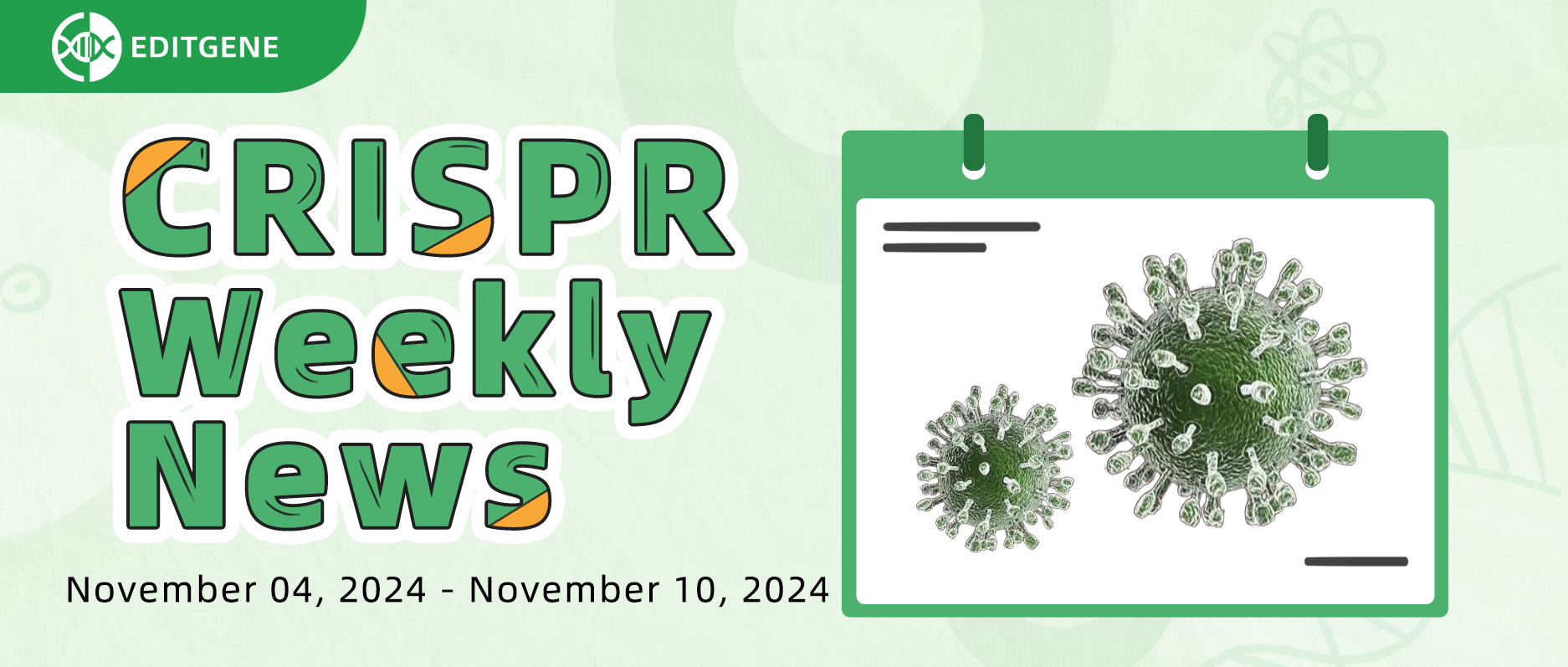Alextina | Dec 28,2024
[Weekly News] Genome-Wide CRISPR Screening: Uncovering New Host Factors to Optimize Rotavirus Vaccine Production

CRISPR/Cas technology is a revolutionary tool in modern biological sciences, with applications spanning medicine, agriculture, environmental conservation, and more. New findings and case studies continue to emerge across these fields. Our ‘CRISPR Weekly News’ column brings you the latest research and industry updates. Here's a brief summary of the past week's highlights :
I. Research Updates
1. Title:CRISPR/Cas9 screens identify key host factors that enhance rotavirus reverse genetics efficacy and vaccine production
Journal:npj Vaccines(Impact Factor:6.9)
Original Link:https://doi.org/10.1038/s41541-024-01007-7
Rotavirus poses a significant threat to young children. To identify new host factors that either promote or inhibit rotavirus infection, researchers conducted a genome-wide CRISPR/Cas9 screening using rhesus monkey rotavirus and African green monkey kidney cells.
In MA104 cells, knockout of SERPINB1 or TMEM236—two previously identified antiviral factors—independently increased viral titers in a strain-independent manner. To address this, the researchers optimized the existing rotavirus reverse genetics system by combining the SERPINB1 knockout MA104 cells with the C3P3-G3 helper plasmid. This combination enhanced the recovery efficiency and successfully rescued several low-titer rotavirus reporter genes and mutant strains.
Additionally, the study demonstrated that the knockout of TMEM236 in Vero cells supported higher yields of two attenuated live rotavirus vaccine strains compared to the parental cell lines, providing a more robust cell substrate for vaccine production.This research led to the development of a third-generation optimized rotavirus reverse genetics system and the creation of gene-edited Vero cells, offering a new substrate for improving rotavirus vaccine production.
2. Title:Large DNA deletions occur during DNA repair at 20-fold lower frequency for base editors and prime editors than for Cas9 nucleases
Journal:Nature Biomedical Engineering(Impact Factor:26.8)
Original Link:https://doi.org/10.1038/s41551-024-01277-5
When used for genome editing, the Cas9 nuclease induces targeted double-strand breaks in DNA. Researchers have reported that the frequency of large DNA deletions (>100 bp) during DNA repair is significantly lower than those caused by Cas9 nuclease. The researchers employed CRISPR interference screening and advanced sequencing to analyze CRISPR-induced DNA deletion in cancer cell lines, stem cells, and T cells.
Cas9-induced double-strand breaks led to large deletions in most cell lines, with frequencies ranging from 0.2% to 17.5%, and an even higher proportion (approximately 15%) in T cells. Additional experiments using small-molecule inhibitors of DNA repair pathways revealed that these deletions were primarily driven by exonucleolytic resection and DNA polymerase θ-mediated end joining.
Although base and prime editors also generated deletions, their frequency was 20 times lower than that of CRISPR-Cas9. The researchers highlighted the importance of validating current gene editing tools for clinical applications. They also proposed their workflow as a strategy to assess unintended large or small DNA changes that may arise during the use of these gene editors.
ii. CRISPR Knockout Cell Lines
1.Title:Nuclear porcupine mediates XRCC6/Ku70 S-palmitoylation in the DNA damage response
Journal:Exp Hematol Oncol(Impact Factor:9.4)
Original Link:https://doi.org/10.1186/s40164-024-00572-w
The activation of DNA damage response (DDR) is largely regulated by the post-translational modifications (PTMs) of proteins. These modifications play a crucial role in preventing genetic instability and tumorigenesis. Among these PTMs, palmitoylation is a highly conserved process, and its dysregulation is observed in many types of cancer. However, its direct relationship with DDR and the underlying mechanisms remain unclear.
To investigate this, researchers used CRISPR/Cas9 technology to generate PORCN knockout and PORCN nuclear localization signal (NLS) knockout cell lines. They validated the role of PORCN NLS in DDR through colony formation assays, MTT assays, DR/EJ5 homologous recombination/non-homologous end joining (NHEJ) reporter systems, xenograft tumor growth, and immunofluorescence. Additionally, they used mass spectrometry, acyl-biotin exchange (ABE) palmitoylation assays, Click-iT assays, subcellular fractionation, Western blot analysis, and in vivo and in vitro co-immunoprecipitation to explore the underlying mechanisms.
The study provides evidence that porcupine (PORCN) is a key component of DDR. Lack of PORCN impairs NHEJ and increases sensitivity to ionizing radiation (IR) both in vitro and in vivo. The researchers found that PORCN has a nuclear domain (nPORCN) with S-acyltransferase activity, which is different from the membrane-bound O-acyltransferase in the endoplasmic reticulum. nPORCN is essential for the activation of NHEJ. Mass spectrometry revealed the presence of the nPORCN complex and showed that nPORCN mediates S-palmitoylation of XRCC6/Ku70 at five specific cysteine sites in response to IR. Mutations in these sites led to increased radiation sensitivity and delayed NHEJ. These findings highlight the important role of nPORCN-dependent Ku70 S-palmitoylation in DDR.
1.Title:Highly Sensitive One-Pot Isothermal Assay Combining Rolling Circle Amplification and CRISPR/Cas12a for Aflatoxin B1 Detection
Journal:Analytical Chemistry(Impact Factor:6.7)
Original Link:https://doi.org/10.1021/acs.analchem.4c03798
Mycotoxins derived from grains are widely present around the world. However, detecting these substances in real samples is challenging due to the lack of efficient and ultra-sensitive methods. Researchers have developed a novel one-pot isothermal assay that combines rolling circle amplification (RCA) and CRISPR/Cas12a to detect aflatoxin B1 (AFB1).
In this method, AFB1 is added to magnetic beads functionalized with AFB1 aptamers and complementary DNA (cDNA). The aptamer specifically recognizes AFB1, which triggers the release of cDNA and activates the RCA reaction. The RCA products then stimulate the trans- and cis-cleavage activities of the CRISPR/Cas12a nuclease. The combined RCA and CRISPR/Cas12a system amplifies cDNA exponentially and enhances the non-specific cleavage of single-stranded DNA reporter genes, improving the detection signal.
This CRISPR/Cas12a-assisted one-pot isothermal assay enables ultra-sensitive detection through fluorescence and visual detection using lateral flow test strips. This makes mycotoxin detection more accessible, especially in resource-limited areas. The detection limits are 0.016 ng/mL and 0.408 ng/mL. This method was successfully applied to real samples, with recovery rates ranging from 90% to 114%. This study presents a powerful and versatile method for reliably detecting mycotoxins in various applications.
iv. Other CRISPR-Related Research
1. Title:An NLR family member X1 mutation (p.Arg707Cys) suppresses hepatitis B virus infection in hepatocytes and favors the interaction of retinoic acid-inducible gene 1 with mitochondrial antiviral signaling protein
Journal:Archives of Virology(Impact Factor:2.5)
Original Link:https://doi.org/10.1007/s00705-024-06133-0
NLR family member X1 (NLRX1) is an important part of the NOD-like receptor (NLR) family and plays a unique role in regulating the immune system. Patients with hepatitis B virus (HBV) infection are more likely to have the NLRX1 mutation, p.Arg707Cys, compared to healthy individuals. Studies have shown that NLRX1 can increase HBV infection in HepG2 cells that express the sodium taurocholate cotransporting polypeptide (NTCP). However, the role of the NLRX1 mutation (p.Arg707Cys) in hepatitis is still not fully cleared.
In this study, researchers used the LV003 lentivirus to generate NTCP overexpression Huh7 stable cell lines. The results revealed that NLRX1 acts as a regulatory factor that suppresses the ability of liver cells to fight HBV. The p.Arg707Cys mutation in NLRX1 inhibits HBV infection and activates the IFN/nuclear factor κB (NF-κB) pathway. By regulating the interaction between NLRX1 and RIG-I/MAVS, the researchers suggests the potential for developing more effective HBV treatments. The findings also provide valuable insights for future research into immune therapies for other viral infections.
2.Title:PTPN20 promotes metastasis through activating NF-κB signaling in triple-negative breast cancer
Journal:Breast Cancer Research(Impact Factor:6.1)
Original Link:https://doi.org/10.1186/s13058-024-01910-w
Cancer metastasis remains a major challenge in the treatment of triple-negative breast cancer (TNBC). The NF-κB signaling pathway is a key factor in metastasis, however, its molecular mechanisms are not fully understood. Researchers used data from the Swedish Breast Cancer Cancer Group Analysis Network and the Cancer Genome Atlas to examine the effects of PTPN20 overexpression and knockdown via shRNA in TNBC cell lines. They also studied tumor growth and metastasis in 4T1 xenograft models in nude mice.
The results showed that PTPN20 levels were higher in TNBC cell lines and patient samples compared to controls. Elevated PTPN20 levels were associated with longer metastasis-free survival. Overexpressing PTPN20 enhanced migration and invasion of TNBC cells in vitro and promoted lung metastasis in vivo. PTPN20 activated NF-κB signaling by dephosphorylating p65 at Ser468, preventing its binding with COMMD1, and protecting p65 from degradation. Reducing PTPN20 expression inhibited TNBC cell migration and invasion, while the p65 S468A mutant restored these abilities.
These findings suggest that PTPN20 plays a key role in TNBC metastasis by activating NF-κB signaling. PTPN20 may serve as a new prognostic marker and a potential therapeutic target for TNBC.
II. Industry News
1. Iovance Therapeutics is sponsoring the first-in-human trial, IOV-GM1-201, to study the effects of PD-1 knockout tumor-infiltrating lymphocyte (TIL) therapy (IOV-4001) in patients with previously treated advanced melanoma and non-small cell lung cancer. The trial is currently in the multi-center Phase 2 efficacy stage and aims to offer new treatment options for patients with refractory cancers. Financial reports also show the company's significant investment in research and development. If successful, this therapy could change the treatment landscape for these cancers in the future.
2. Vertex Pharmaceuticals has announced the latest progress on CASGEVY (also known as exa-cel), a gene therapy developed in collaboration with CRISPR Therapeutics. CASGEVY has been approved and launched in several countries and regions, including the United States, the United Kingdom, the European Union, Saudi Arabia, Bahrain, Canada, and Switzerland. The therapy is designed to treat sickle cell disease and transfusion-dependent β-thalassemia. As an innovative curative treatment, CASGEVY provides patients with new options and represents a major advance in gene editing for blood disorders.
EDITGENE focuses on CRISPR technology, offering a range of high-quality gene editing services and in vitro diagnostic products. These include but are not limited to:CRISPR Library Screening、Cell Line Engineering、Monoclonal Cell Line Screening、CRISPR Detection.We are committed to providing the most efficient technical services for CRISPR-related, gene function research, in vitro diagnostics, and therapeutic research.
Recent Blogs
1.[Literature Review] Unlocking CRISPR-Cas12a's Full Potential: Enhancing Trans-Cleavage with Variants
2.[Weekly News] CRISPR Screening Revealing TMEM106B as a Mediator of an ACE2-Independent Infection Pathway for SARS-CoV-2
3.[Literature Review] Gene Knockout of ERAP1 Provides New Insights for Optimizing Tumor Immunotherapy
Follow us on social media
Contact us
+ 833-226-3234 (USA Toll-free)
+1-224-345-1927 (USA)
info@editxor.com


 Login
Login










![[Weekly News] Genome-Wide CRISPR Screening: Uncovering New Host Factors to Optimize Rotavirus Vaccine Production](/uploads/20241115/8gYqyNTuHPdLstf9_ce9a01bd08f9d18c7d09fad585bc559f.jpg)



Comment (4)